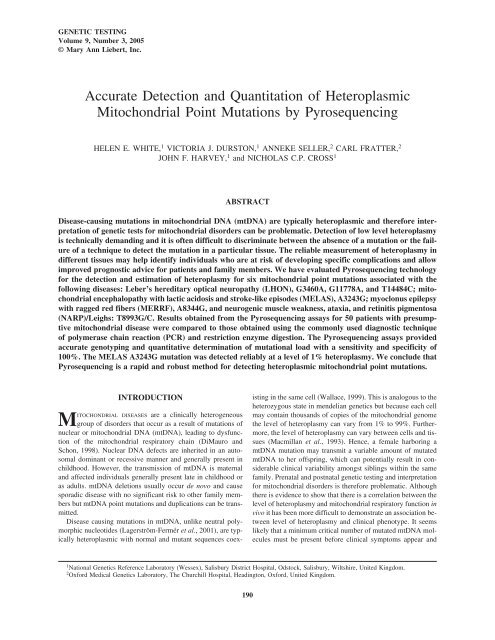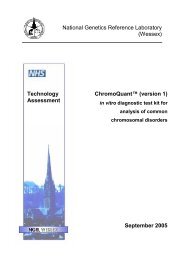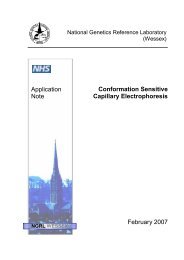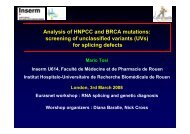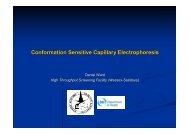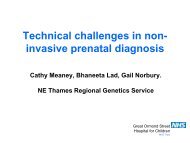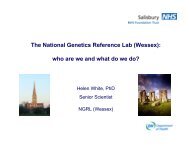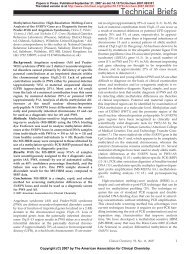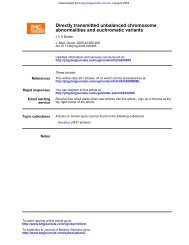Accurate Detection and Quantitation of Heteroplasmic Mitochondrial ...
Accurate Detection and Quantitation of Heteroplasmic Mitochondrial ...
Accurate Detection and Quantitation of Heteroplasmic Mitochondrial ...
You also want an ePaper? Increase the reach of your titles
YUMPU automatically turns print PDFs into web optimized ePapers that Google loves.
GENETIC TESTINGVolume 9, Number 3, 2005© Mary Ann Liebert, Inc.<strong>Accurate</strong> <strong>Detection</strong> <strong>and</strong> <strong>Quantitation</strong> <strong>of</strong> <strong>Heteroplasmic</strong><strong>Mitochondrial</strong> Point Mutations by PyrosequencingHELEN E. WHITE, 1 VICTORIA J. DURSTON, 1 ANNEKE SELLER, 2 CARL FRATTER, 2JOHN F. HARVEY, 1 <strong>and</strong> NICHOLAS C.P. CROSS 1ABSTRACTDisease-causing mutations in mitochondrial DNA (mtDNA) are typically heteroplasmic <strong>and</strong> therefore interpretation<strong>of</strong> genetic tests for mitochondrial disorders can be problematic. <strong>Detection</strong> <strong>of</strong> low level heteroplasmyis technically dem<strong>and</strong>ing <strong>and</strong> it is <strong>of</strong>ten difficult to discriminate between the absence <strong>of</strong> a mutation or the failure<strong>of</strong> a technique to detect the mutation in a particular tissue. The reliable measurement <strong>of</strong> heteroplasmy indifferent tissues may help identify individuals who are at risk <strong>of</strong> developing specific complications <strong>and</strong> allowimproved prognostic advice for patients <strong>and</strong> family members. We have evaluated Pyrosequencing technologyfor the detection <strong>and</strong> estimation <strong>of</strong> heteroplasmy for six mitochondrial point mutations associated with thefollowing diseases: Leber’s hereditary optical neuropathy (LHON), G3460A, G11778A, <strong>and</strong> T14484C; mitochondrialencephalopathy with lactic acidosis <strong>and</strong> stroke-like episodes (MELAS), A3243G; myoclonus epilepsywith ragged red fibers (MERRF), A8344G, <strong>and</strong> neurogenic muscle weakness, ataxia, <strong>and</strong> retinitis pigmentosa(NARP)/Leighs: T8993G/C. Results obtained from the Pyrosequencing assays for 50 patients with presumptivemitochondrial disease were compared to those obtained using the commonly used diagnostic technique<strong>of</strong> polymerase chain reaction (PCR) <strong>and</strong> restriction enzyme digestion. The Pyrosequencing assays providedaccurate genotyping <strong>and</strong> quantitative determination <strong>of</strong> mutational load with a sensitivity <strong>and</strong> specificity <strong>of</strong>100%. The MELAS A3243G mutation was detected reliably at a level <strong>of</strong> 1% heteroplasmy. We conclude thatPyrosequencing is a rapid <strong>and</strong> robust method for detecting heteroplasmic mitochondrial point mutations.INTRODUCTIONMITOCHONDRIAL DISEASES are a clinically heterogeneousgroup <strong>of</strong> disorders that occur as a result <strong>of</strong> mutations <strong>of</strong>nuclear or mitochondrial DNA (mtDNA), leading to dysfunction<strong>of</strong> the mitochondrial respiratory chain (DiMauro <strong>and</strong>Schon, 1998). Nuclear DNA defects are inherited in an autosomaldominant or recessive manner <strong>and</strong> generally present inchildhood. However, the transmission <strong>of</strong> mtDNA is maternal<strong>and</strong> affected individuals generally present late in childhood oras adults. mtDNA deletions usually occur de novo <strong>and</strong> causesporadic disease with no significant risk to other family membersbut mtDNA point mutations <strong>and</strong> duplications can be transmitted.Disease causing mutations in mtDNA, unlike neutral polymorphicnucleotides (Lagerström-Fermér et al., 2001), are typicallyheteroplasmic with normal <strong>and</strong> mutant sequences coexistingin the same cell (Wallace, 1999). This is analogous to theheterozygous state in mendelian genetics but because each cellmay contain thous<strong>and</strong>s <strong>of</strong> copies <strong>of</strong> the mitochondrial genomethe level <strong>of</strong> heteroplasmy can vary from 1% to 99%. Furthermore,the level <strong>of</strong> heteroplasmy can vary between cells <strong>and</strong> tissues(Macmillan et al., 1993). Hence, a female harboring amtDNA mutation may transmit a variable amount <strong>of</strong> mutatedmtDNA to her <strong>of</strong>fspring, which can potentially result in considerableclinical variability amongst siblings within the samefamily. Prenatal <strong>and</strong> postnatal genetic testing <strong>and</strong> interpretationfor mitochondrial disorders is therefore problematic. Althoughthere is evidence to show that there is a correlation between thelevel <strong>of</strong> heteroplasmy <strong>and</strong> mitochondrial respiratory function invivo it has been more difficult to demonstrate an association betweenlevel <strong>of</strong> heteroplasmy <strong>and</strong> clinical phenotype. It seemslikely that a minimum critical number <strong>of</strong> mutated mtDNA moleculesmust be present before clinical symptoms appear <strong>and</strong>1 National Genetics Reference Laboratory (Wessex), Salisbury District Hospital, Odstock, Salisbury, Wiltshire, United Kingdom.2 Oxford Medical Genetics Laboratory, The Churchill Hospital, Headington, Oxford, United Kingdom.190
QUANTITATION OF HETEROPLASMIC MITOCHONDRIAL MUTATIONS 191that the pathogenic threshold will be lower in tissues that aredependent on oxidative metabolism. The reliable measurement<strong>of</strong> heteroplasmy <strong>of</strong> various mutations in different tissues mayhelp identify individuals who are at risk <strong>of</strong> developing specificcomplications <strong>and</strong> allow improved prognostic advice for patients<strong>and</strong> family members.For mutations such as the MELAS mutation (A3243G) it isaccepted that higher levels <strong>of</strong> mutated mtDNA are detected inmuscle rather than rapidly dividing tissue (e.g., blood). However,most diagnostic laboratories receive samples that can beobtained in a noninvasive manner such as blood, hair, <strong>and</strong> buccalswabs that may contain a lower level <strong>of</strong> mutated mtDNA.Therefore, diagnostic techniques must be capable <strong>of</strong> reliablydetecting low levels <strong>of</strong> heteroplasmy in such samples. A number<strong>of</strong> established techniques have been used to genotype <strong>and</strong>quantitate the level <strong>of</strong> heteroplasmy for a variety <strong>of</strong> mitochondrialmutations; denaturing gradient gel electrophoresis (Tullyet al., 2000), single-str<strong>and</strong>ed conformational polymorphism(Mashima et al., 1995; Tanno et al., 1995), real-time fluorescentpolymerase chain reaction (PCR; Szuhai et al., 2001; Bai<strong>and</strong> Wong, 2004; He et al., 2002), temporal temperature gradientgel electrophoresis (Boles et al., 2001), Invader technology(Mashima et al., 2004), denaturing high-performanceliquid chromatography (DHPLC) (Conley et al., 2003),solid-phase minisequencing (Juvonen et al., 1994; Suomalainen<strong>and</strong> Syvanen, 2000), <strong>and</strong> PCR-restriction fragment length polymorphism(RFLP); (e.g. Holt et al., 1990). At present, the mostcommonly used diagnostic technique used in the United Kingdomis PCR-RFLP (either radioactive or fluorescent). Here wedescribe the use <strong>of</strong> Pyrosequencing to genotype <strong>and</strong> estimatethe level <strong>of</strong> heteroplasmy for six mitochondrial point mutationsassociated with the following diseases: Leber’s hereditary opticalneuropathy (LHON), G3460A, G11778A, <strong>and</strong> T14484C;mitochondrial encephalopathy with lactic acidosis <strong>and</strong> strokelikeepisodes (MELAS), A3243G; myoclonus epilepsy withragged red fibers (MERRF), A8344G; <strong>and</strong> neurogenic muscleweakness, ataxia, <strong>and</strong> retinitis pigmentosa (NARP/Leighs):T8993G/C.MATERIALS AND METHODSDNA samples <strong>and</strong> PCR-RFLP analysisTotal genomic DNA samples from 50 patients (25 males, 25females; 45 extracted from peripheral blood, 5 extracted frommuscle) with presumptive mitochondrial disease were initiallyanalyzed by the commonly used diagnostic method <strong>of</strong> PCR (fluorescentor nonfluorescent) followed by restriction enzyme digestionusing the PCR primers listed in Table 1. Ampliconswere generated in a 20-l reaction volume with 5 pmol <strong>of</strong> forward<strong>and</strong> reverse PCR primers, 0.2 mM dNTPs (Promega,Madison, WI), 1X Hotstar Buffer with MgCl 2 (Qiagen, Valencia,CA), 1 unit Hotstar Taq (QIAGEN) using 10 ng genomicDNA. PCR conditions for all reactions were 94°C for 12 min;30 cycles with denaturation at 94°C for 30 sec, annealing at58°C for 30 sec <strong>and</strong> elongation at 72°C for 30 sec; 1 cycle at72°C for 10 minutes; <strong>and</strong> a final hold at 4°C. Thermocyclingwas performed using a PTC-0225 DNA Engine Tetrad (MJ Research,Waltham, MA). 5 l PCR product was digested with 2units <strong>of</strong> the appropriate restriction enzyme according to manufacturer’sinstructions.The LHON mutations G3460A, G11778A, <strong>and</strong> T14484Cwere analyzed by nonfluorescent PCR <strong>and</strong> restriction digestionwith AcyI (G3460A causes site loss), MaeIII (G11778A causessite gain) <strong>and</strong> BanI (primer mismatch creates site for T14484C).The MELAS A3243G, MERRF A8344G, <strong>and</strong> NARP/LeighsT8993G/C were analyzed by fluorescent PCR. To prevent heteroduplexformation <strong>and</strong> consequent variability in restrictionenzyme digestion, fluorescently labeled reverse primer wasadded after 30 PCR cycles <strong>and</strong> a single extension reaction wasperformed. The restriction enzymes used for analysis <strong>of</strong> thesemutations were HpaII (site gain for the T8993G/C mutation),HaeIII (site loss for G8994A polymorphism), BglI (site gain forA8344G), <strong>and</strong> ApaI (site gain for A3243G). After digestion,fluorescent products were analyzed using an ABI 3100 GeneticAnalyser (Applied Biosystems, Foster City, CA) <strong>and</strong> the level<strong>of</strong> heteroplasmy determined by comparison <strong>of</strong> the cleaved <strong>and</strong>uncleaved peak areas. Nonfluorescent products were analysedusing agarose gel electrophoresis.Pyrosequencing assaysPyrosequencing technology is a real-time sequencingmethod for the analysis <strong>of</strong> short to medium length DNA sequences(Ronaghi et al., 1998). Four enzymes <strong>and</strong> specific substratesare used to produce light whenever a nucleotide formsa base pair with the complementary base in a DNA templatestr<strong>and</strong>. Biotinylated PCR products are converted to singlestr<strong>and</strong>edtemplates onto which a sequencing primer is annealed.Analysis begins as the enzymes <strong>and</strong> substrates are dispensedinto the reaction, nucleotides are dispensed sequentially <strong>and</strong> alight signal is detected <strong>and</strong> the base registered. If the added nucleotideis not complementary to the next base in the templatethen no light is generated. The genotype <strong>of</strong> the mtDNA can bedetermined using the PSQ 96MA System <strong>and</strong> the percentage<strong>of</strong> mutated mtDNA present in the sample can be quantified usingthe allele frequency quantification function <strong>of</strong> the SNP s<strong>of</strong>tware(Biotage AB, Uppsala, Sweden).DNA samples were r<strong>and</strong>omized <strong>and</strong> reanalyzed in a blindedfashion for all six mutations using Pyrosequencing technology.Interassay <strong>and</strong> intra-assay variation for each mutation wasdetermined by analyzing 15 normal control samples in 6 independentexperiments <strong>and</strong> mutated samples were analysed intriplicate to determine reproducibility <strong>of</strong> results.PCR amplification <strong>and</strong> clean-up. The sequences <strong>of</strong> PCR <strong>and</strong>sequencing primers (Thermo Electron) used for each assay arelisted in Table 1. Amplicons were generated in a 50-l reactionvolume with 15 pmol <strong>of</strong> forward <strong>and</strong> reverse PCR primers,0.2 mM dNTPs (Promega), 1.5 mM MgCl 2 , 1 Buffer II (AppliedBiosystems), 1 unit AmpliTaq Gold (Applied Biosystems)using 10 ng genomic DNA. PCR conditions for all reactionswere 94°C for 7 minutes; 50 cycles with denaturation at 94°Cfor 30 sec, annealing at 60°C for 30 sec <strong>and</strong> elongation at 72°Cfor 30 sec; 1 cycle at 72°C for 7 min; <strong>and</strong> a final hold at 4°C.Thermocycling was performed using a PTC-0225 DNA EngineTetrad (MJ Research).Single-str<strong>and</strong>ed biotinylated PCR products were prepared forsequencing using the Pyrosequencing Vacuum Prep Tool.
TABLE 1. SEQUENCES OF OLIGONUCLEOTIDES REQUIRED FOR THE PYROSEQUENCING AND RFLP ASSAYSMutation Oligonucleotides Sequence 5 to 3 Sequence to analyze Dispensation orderA3243G RFLP Fwd PCR AGGACAAGAGAAATAAGGCCMELAS RFLP Rev PCR TAGAAGAGCGATGGTGAGAGPyrosequencing Fwd PCR CCTCCCTGTACGAAAGGACAPyrosequencing Rev PCR Biotin-TGGCCATGGGTATGTTGTTAPyrosequencing Sequencing GGTTTGTTAAGATGGCAG (A/G) GCCCGGTAATC CAGTCGTATA8344G RFLP Fwd PCR GTAGTATTTAGTTGGGGCATTTCACTGTAAAGCCGTGTTGGMERRF RFLP Rev PCR CTACCCCCTCTAGAGCCCACPyrosequencing Fwd PCR CATGCCCATCGTCCTAGAATPyrosequencing Rev PCR Biotin-TTTTATGGGCTTTGGTGAGGPyrosequencing Sequencing TAAGTTAAAGATTAAGAGA (A/G) CCAACACCT TAGTCACACG3460A RFLP Fwd PCR AGGACAAGAGAAATAAGGCCLHON RFLP Rev PCR TAGAAGAGCGATGGTGAGAGPyrosequencing Fwd PCR Biotin-ATGGCCAACCTCCTACTCCTPyrosequencing Rev PCR TAGATGTGGCGGGTTTTAGGPyrosequencing Sequencing TCTTTGGTGAAGAGTTTTAT GG (C/T) GTCAG AGCTCGTCAG11778A RFLP Fwd PCR CAGCCACAGAACTAATCATALHON RFLP Rev PCR GTAAGCCTCTGTTCTCAGATPyrosequencing Fwd PCR Biotin-CAGCCATTCTCATCCAAACCPyrosequencing Rev PCR CAGAGAGTTCTCCCAGTAGGTTAATPyrosequencing Sequencing AGTCCTTGAGAGAGGATTAT GATG (C/T) GA CGATGCTCGT14484C RFLP Fwd PCR AGTATATCCAAAGACAGGCALHON RFLP Rev PCR GGTTTAGTATTGATTGTTAGCPyrosequencing Fwd PCR CCCCACTAAAACACTCACCAAPyrosequencing Rev PCR Biotin-TGGGTTTAGTAATGGGGTTTGPyrosequencing Sequencing TGTAGTATATCCAAAGACA ACCA (T/C) CATTC GACATCGATT8993G/C RFLP Fwd PCR CCGACTAATCACCACCCAACNARP/Leighs RFLP Rev PCR TGTCGTGCAGGTAGAGGCTTPyrosequencing Fwd PCR AGGCACACCTACACCCCTTAPyrosequencing Rev PCR Biotin-TGTGAAAACGTAGGCTTGGATPyrosequencing Sequencing CATTCAACCAATAGCCC (T/G/C) GGCCGTACG CTGTACGTACFor the Pyrosequencing assays, the sequence to analyse is immediately 3 to the sequencing primer binding site on the biotinylated str<strong>and</strong>. The position <strong>of</strong> the mutation is shown inbrackets (bold). The dispensation order <strong>of</strong> the nucleotides includes several reference peaks, where no signal should be observed, these are shown in italics (T8993G/C assay has an additionalreference peak included at dispensation 6 to detect the G8994A polymorphism). The dispensation orders used were those determined by the s<strong>of</strong>tware in the Simplex SNP entryfunction.
QUANTITATION OF HETEROPLASMIC MITOCHONDRIAL MUTATIONS 193Three microliters <strong>of</strong> Streptavidin Sepharose HP (Amersham,Piscataway, NJ) was added to 37 l binding buffer (10 mMTris-HCl pH 7.6, 2 M NaCl, 1 mM ethylenediaminetetraaceticacid [EDTA], 0.1% Tween 20) <strong>and</strong> mixed with 20 L PCRproduct <strong>and</strong> 20 l high purity water for 10 min at room temperatureusing a Variomag Monoshaker (Camlab, Cambridge,UK). The beads containing the immobilized templates werecaptured onto the filter probes after applying the vacuum <strong>and</strong>then washed with 70% ethanol for 5 sec, denaturation solution(0.2 M NaOH) for 5 seconds <strong>and</strong> washing buffer (10 mM Tris-Acetate pH 7.6) for 5 seconds. The vacuum was then released<strong>and</strong> the beads released into a PSQ 96 Plate Low containing 45l annealing buffer (20 mM Tris-Acetate, 2 mM MgAc 2 pH7.6), 0.3 M sequencing primer. For the T8993C/G assay, wefound it necessary to add 1 l single str<strong>and</strong>ed binding protein(Promega, 2.2 g/l) to eliminate secondary structure in thetemplate DNA. The samples were heated to 80°C for 2 min <strong>and</strong>then allowed to cool to room temperature.Pyrosequencing reactions <strong>and</strong> data analysis. Pyrosequencingreactions were performed according to the manufacturer’sinstructions using the PSQ 96 SNP Reagent Kit, which containedthe enzyme <strong>and</strong> substrate mixture <strong>and</strong> nucleotides. Assayswere performed using the nucleotide dispensation ordersshown in Table 1. The sample genotype <strong>and</strong> percent heteroplasmywere determined using the allele frequency quantification(AQ) function in the SNP S<strong>of</strong>tware (Biotage AB). Sampleswere considered to have the mutation if the value <strong>of</strong> percentheteroplasmy was greater than three st<strong>and</strong>ard deviations fromthe mean value obtained from the normal replicates.Threshold detection <strong>of</strong> A3243G mutationDNA samples with known levels <strong>of</strong> heteroplasmy were preparedto determine the lowest level <strong>of</strong> the A3243G mutationthat could be detected reliably. In 2004, Urata <strong>and</strong> colleaguesanalyzed 40 healthy donors <strong>and</strong> MELAS patients using peptidenucleic acid probe-directed PCR clamping <strong>and</strong> demonstratedthat a mutational load as low as 0.1% can be clinically significant.Therefore, the detection <strong>of</strong> low frequency heteroplasmyfor this mutation is particularly important. DNA from a MELASpatient was amplified using the primers 5 tgcagccgctattaaaggtt3 <strong>and</strong> 5 ggttcggttggtctctgcta 3 (amplified region 3014–3894). The resulting 880-bp amplicon was cloned into the vectorpCR2.1 (Invitrogen, Carlsbad, CA) <strong>and</strong> several colonieswere sequenced to identify 2 clones; one with a wild-type genotype<strong>and</strong> the other with the MELAS mutation. DNA from eachclone was quantified <strong>and</strong> diluted to a final concentration equivalentto 2 10 4 mitochondrial genomes per microliter (dilutedin 10 ng salmon sperm DNA). The wild-type <strong>and</strong> mutated DNAwere mixed to generate samples with the A3243G mutationpresent at levels ranging from 1%–100%. Each sample was analyzedin triplicate using the Pyrosequencing assay, fluorescent<strong>and</strong> nonfluorescent PCR-RFLP (using identical primersets), <strong>and</strong> the detection threshold for each technique was determined.RESULTSSensitivity, specificity, <strong>and</strong> reproducibilityTo determine the background levels for each Pyrosequencingassay, 15 normal DNA samples were analyzed in six independentexperiments. The mean <strong>and</strong> st<strong>and</strong>ard deviation valuesfor intra <strong>and</strong> inter assay analysis are shown in Table 2. Nodifferences were observed between the interassay <strong>and</strong> intra-assayanalysis, which suggests that the background variation seenin these assays is consistent <strong>and</strong> that the assays are robust. Figure1 shows the genotype <strong>and</strong> percent heteroplasmy obtainedfrom the 50 patient DNA samples using the Pyrosequencing assayscompared to the results obtained using the routine PCR-RFLP method for all mutated samples. Error bars for the Pyrosequencingdata indicate the st<strong>and</strong>ard deviation for triplicateanalysis. Samples were considered to harbor the mutation if theAQ value obtained was greater than three st<strong>and</strong>ard deviationsTABLE 2. INTERASSAY AND INTRA-ASSAY ANALYSIS OF FIFTEEN NORMAL SAMPLES TESTED IN SIX INDEPENDENT EXPERIMENTSTO DETERMINE LEVEL OF BACKGROUND DETECTION OF MUTANT ALLELE FOR EACH ASSAYInterassay analysis (n 15) Intra-assay analysis (n 6)St<strong>and</strong>ardSt<strong>and</strong>ardMutation Mean deviation Mean deviation Mean 3SDA3460G 2.86 1.62 2.88 1.62 7.72LHONG11778A 0.05 0.14 0.06 0.22 0.72LHONT14484C 2.13 0.63 2.13 0.98 5.07LHONA3243G 0.06 0.07 0.06 0.11 0.39MELASA8344G 0.13 0.32 0.13 0.50 1.63MERRFT8993G/C 0.01 0.02 0.01 0.03 0.04NARP/LeighsSD, st<strong>and</strong>ard deviation.
194WHITE ET AL.FIG. 1. Percentage heteroplasmy detected by the Pyrosequencing assays compared to the diagnostic result obtained using nonfluorescentpolymerase chain reaction-restriction fragment length polymorphism (PCR-RFLP). A: G3460A. B: G11778A. C:T14484C <strong>and</strong> fluorescent PCR-RFLP. D: A3243G. E: T8993G/C. F: A8344G. The x axis shows the sample number <strong>and</strong> the yaxis shows the percentage heteroplasmy detected. In graphs (a) to (c) the 100% heteroplasmy obtained for PCR-RFLP indicatesthat no wild-type product was viewed on a 3% agarose gel after restriction enzyme digestion.from the mean value obtained from the normal replicated samples(Table 2). The genotypes obtained using the Pyrosequencingassays were 100% concordant with those obtained usingPCR-RFLP <strong>and</strong> the levels <strong>of</strong> heteroplasmy detected usingboth techniques were essentially identical. Of the 50 patientDNA samples 13 were found to have 1 <strong>of</strong> the 3 LHON mutations,10 had the A3243G MELAS mutation, 4 were positivefor the MERRF A8344G mutation, 4 carried the NARP/LeighsT8993G/C mutation, <strong>and</strong> no mutation was detected in 19 samples.None <strong>of</strong> the samples had the G8994A polymorphism. ThePyrosequencing assays were 100% sensitive <strong>and</strong> 100% specifictaking into account the respective background values. The determination<strong>of</strong> the level <strong>of</strong> heteroplasmy using the Pyrosequencingassays was highly reproducible. For the mutated samplesanalyzed in triplicate, no deviation from the mean wasobserved for the 3 LHON assays <strong>and</strong> the coefficient <strong>of</strong> variancefor the 3243, 8344, <strong>and</strong> 8993 assays was 1.2–52.7,1.65–5.47, <strong>and</strong> 0.6–3.5 respectively. Representative pyrogramsobtained for a mutated sample from each assay are shown inFigure 2.Threshold detection <strong>of</strong> A3243G mutationThe lowest level <strong>of</strong> detection <strong>of</strong> the A3243 mutation for thePyrosequencing, nonfluorescent PCR-RFLP <strong>and</strong> fluorescentPCR-RFLP assay was determined by generating a st<strong>and</strong>ardcurve from cloned wild-type <strong>and</strong> mutated DNA samples thathad been mixed to generate samples with the A3243G mutationpresent at levels <strong>of</strong> 0%, 1%, 2.5%, 5%, 10%, 20%, 30%,40%, 50%, 60%, 70%, 80%, 90%, <strong>and</strong> 100%. Figure 3 showsthe st<strong>and</strong>ard curves for the Pyrosequencing <strong>and</strong> fluorescentPCR-RFLP assays for identical samples analyzed in triplicate.A level <strong>of</strong> 1% heteroplasmy was reliably detected with a meanAQ value <strong>of</strong> 1.73 (st<strong>and</strong>ard deviation 0.84). Results from thefluorescent PCR-RFLP show that 5% heteroplasmy is the limit<strong>of</strong> detection for this technique. In contrast to the expected linearrelationship between observed <strong>and</strong> expected heteroplasmylevels for the Pyrosequencing assay an apparent quadratic relationshipwas seen for PCR-RFLP. This may reflect the underrepresentation<strong>of</strong> heteroplasmy detected because <strong>of</strong> the formation<strong>of</strong> heteroduplexes that cannot be cut by the restrictionenzyme. Analysis <strong>of</strong> the same PCR products by agarose gelelectrophoresis detected the mutation with a sensitivity <strong>of</strong> only20% (data not shown) which is consistent with other studies(Hancock et al., 2002).Cost-effectiveness <strong>and</strong> speed <strong>of</strong> analysisCostings for the Pyrosequencing assays <strong>and</strong> fluorescentPCR-RFLP using 2004 list prices were comparable to the costper sample being £1.20 (GBP) <strong>and</strong> £1.17, respectively, excludingsystem costs <strong>and</strong> machine maintenance contracts. Af-
QUANTITATION OF HETEROPLASMIC MITOCHONDRIAL MUTATIONS 195FIG. 2. Representative pyrograms for representative patient samples that are heteroplasmic for (A) G3460A, (B) G11778A,(C) T14484C, (D) A3243G, (E) A8344G, <strong>and</strong> (F) T8993G. The arrows mark the position corresponding to the mutated base.The boxes show the AQ values obtained for each allele, the value for the mutated allele represents the level <strong>of</strong> heteroplasmypresent in the sample.ter the PCR, the analysis time is faster using the Pyrosequencingsystem with a result being available in 30 minutes as comparedto 2 hours for fluorescent PCR-RFLP.DISCUSSIONMany commonly used molecular biology techniques havebeen adapted to characterize <strong>and</strong> quantitate mitochondrial mutations.With the continuing discovery <strong>of</strong> new mitochondrialmutations <strong>and</strong> increasing dem<strong>and</strong> for molecular testing, it is importantthat clinically relevant levels <strong>of</strong> heteroplasmy can bedetected in a reliable <strong>and</strong> time- <strong>and</strong> cost-effective manner. It istechnically possible to undertake prenatal diagnosis <strong>and</strong> geneticcounselling for mtDNA mutations but predicting the severity<strong>and</strong> type <strong>of</strong> symptoms has been hampered by the problems associatedwith interpreting the level <strong>of</strong> heteroplasmy. Here, wehave examined how Pyrosequencing can be used effectively togenotype <strong>and</strong> estimate the level <strong>of</strong> heteroplasmy for six mitochondrialmutations compared to the widely used diagnostictechnique PCR-RFLP analysis.Ninety-five percent <strong>of</strong> LHON patients harbor one <strong>of</strong> threemtDNA point mutations that affect genes encoding complex 1subunits <strong>of</strong> the respiratory chain; G11778A (Wallace et al.,1988), T14484C (Johns et al., 1992), <strong>and</strong> G3460A (Huoponenet al., 1991). They differ from other pathogenic mitochondrialmutations because in the majority <strong>of</strong> pedigrees affected familymembers are homoplasmic for these mutations (Thornburn <strong>and</strong>Dahl, 2001). In our study 13 samples were identified as havingone <strong>of</strong> the LHON mutations by PCR-RFLP. The Pyrosequencingassays correctly genotyped these 13 samples <strong>and</strong> also producedreliable estimates <strong>of</strong> heteroplasmy with a sensitivity <strong>and</strong>specificity <strong>of</strong> 100%. The assay for the G3460A mutationshowed the highest level <strong>of</strong> background signal for normal sampleswith a mean AQ value for the A allele <strong>of</strong> 2.88% (st<strong>and</strong>arddeviation 1.62), which precludes the detection <strong>of</strong> samples withlevels <strong>of</strong> heteroplasmy below 8%. However, because LHONmutations are usually homoplasmic this does not represent asignificant problem when using this assay in a diagnostic setting.The assays for G11778A <strong>and</strong> T14484C were very robust<strong>and</strong> reproducible <strong>and</strong> had low background signals for normalsamples.The tRNA gene mutation A3243G was first described byCiafaloni et al. in a MELAS patient (Ciafaloni et al., 1992).Eighty percent <strong>of</strong> patients with MELAS have the A3243G mutation,which is the most common mtDNA point mutation detectedin approximately 2000 patients with suspected mtDNAdisorders (Wong <strong>and</strong> Senadheera, 1997; Liang <strong>and</strong> Wang,1998). The mutation is associated with stroke-like episode <strong>and</strong>mitochondrial myopathy (MELAS) when present at more than85% mutant load but is associated with maternally inherited diabetesmellitus <strong>and</strong> deafness when present at a lower percentage(0.1%–30%). Hence, the detection <strong>of</strong> low-frequency heteroplasmyfor this mutation is particularly important because itcan be clinically significant. The mutation is usually present inlow amounts in tissues that can be sampled in a noninvasivemanner (e.g., blood) <strong>and</strong> it appears that levels <strong>of</strong> the mutationdecrease in blood <strong>and</strong> increase in muscle over time. Sensitive
196detection methods are therefore important for mutation detectionin elderly patients because this can alleviate the need formore invasive muscle biopsy samples to be taken. In our study10 patients (9 peripheral blood samples <strong>and</strong> 1 muscle biopsy)were found to have the A3243G mutation. The data from thePyrosequencing assays correlated well with results obtained usingPCR-RFLP <strong>and</strong> the assay had a sensitivity <strong>and</strong> specificity<strong>of</strong> 100% with a cut<strong>of</strong>f AQ value <strong>of</strong> 0.39%. The Pyrosequencingassay had very low-level background signals with a meanAQ value for the G allele <strong>of</strong> 0.06% (st<strong>and</strong>ard deviation 0.11)determined by the analysis <strong>of</strong> the normal samples. Using sampleswith known mutation loads it was established that the lowestlevel <strong>of</strong> heteroplasmy that could be detected reliably was1% that produced a mean AQ value <strong>of</strong> 1.73% (st<strong>and</strong>ard deviation0.84) in the Pyrosequencing assay. This threshold level <strong>of</strong>detection should be adequate for most clinical diagnostic laboratories.The A8344G mutation in the tRNA Lys gene was first describedby Silvestri et al. in association with myoclonic epilepsyWHITE ET AL.with red ragged fibers (Silvestri et al., 1993). The pathogenicMELAS <strong>and</strong> MERRF mutations both affect the mitochondrialtRNA genes <strong>and</strong> they have similar effects on the respiratory chainin vitro. As for the MELAS A3243G, there is a correlation betweenpercent heteroplasmy <strong>and</strong> clinical features in muscle biopsysamples where patients with more than 90% mutated DNAin muscle are more likely to have deafness, ataxia, <strong>and</strong> myoclonusthan patients who have mutated DNA present at more than 80%(Chinnery et al., 1997). Unlike the A3243G mutation individualswith A8344G <strong>of</strong>ten have similar levels <strong>of</strong> mutant mtDNA intheir blood <strong>and</strong> muscle. Four patients in this study were found tohave the MERRF A8344G mutation present in peripheral bloodsamples using both Pyrosequencing <strong>and</strong> PCR-RFLP. The level<strong>of</strong> heteroplasmy determined by Pyrosequencing assay correlatedwell to that detected using PCR-RFLP. Again, the Pyrosequencingassay had very low background with the mean AQ value forthe G allele in normal samples being 0.13 (st<strong>and</strong>ard deviation0.5) <strong>and</strong> the assay results were reproducible with a sensitivity<strong>and</strong> specificity <strong>of</strong> 100%.A100% heteroplasmy obtained usingPyrosequencing908070605040302010y = 0.96x + 0.73R 2 = 0.99B100001020304050 60Theoretical % heteroplasmy708090100110% heteroplasmy obtained usingPCR RFLP908070605040302010y = 0.92x − 5.83R 2 = 0.98001020304050 60Theoretical % heteroplasmy708090100110FIG. 3. St<strong>and</strong>ard curves from cloned wild type <strong>and</strong> mutated DNA samples which have been mixed to generate samples withthe A3243G mutation present at levels <strong>of</strong> 0, 1, 2.5, 5, 10, 20, 30, 40, 50, 60, 70, 80, 90, <strong>and</strong> 100% (x axis). Error bars indicatethe st<strong>and</strong>ard deviation for triplicate samples. A: St<strong>and</strong>ard curve for the Pyrosequencing assay showing a linear relationship betweenthe percentage heteroplasmy present in the samples <strong>and</strong> the percentage heteroplasmy detected by the Pyrosequencing assay.The lowest reliable level <strong>of</strong> A3243G detection was 1% (0.5% not tested). B: St<strong>and</strong>ard curve for the polymerase chain reaction-restrictionfragment length polymorphism (PCR-RFLP) assay showing the linear (solid line) <strong>and</strong> quadratic (dotted line; y 0.005x 2 0.42x 0.94, R 2 0.99) relationships between the percentage heteroplasmy present in the samples <strong>and</strong> the percentageheteroplasmy determined by analysis <strong>of</strong> the cleaved <strong>and</strong> uncleaved peak areas after restriction digestion. The lowest reliablelevel <strong>of</strong> A3243G detection was 5%.
QUANTITATION OF HETEROPLASMIC MITOCHONDRIAL MUTATIONS 197The T8993G/C mutation affects the ATP synthase 6 subunitresulting in reduced ATP synthesis <strong>and</strong> is invariably heteroplasmic.It was first reported in 1990 in a family with NARPsyndrome (Holt et al., 1990). The T8993G <strong>and</strong> T8993C mutationsare among the most common mtDNA mutations reportedin children <strong>and</strong> the T8993C mutation is generally considered tobe a milder variant (Rahman et al., 1996; Santorelli et al., 1997).Variable clinical expression within families has been reported<strong>and</strong> two main phenotypes have been identified; NARP syndrome<strong>and</strong> maternally inherited Leigh syndrome that can be distinguishedby different degrees <strong>of</strong> heteroplasmy <strong>of</strong> the T8993Gmutation. Symptoms usually appear when the mutant load isgreater than 60% with retinal dystrophy related visual loss beingthe prevalent symptom in the 60%–75% range; NARP syndromeusually occurs between 75% <strong>and</strong> 90% heteroplasmy. Themore severe phenotype <strong>of</strong> Leigh syndrome occurs when levelsincrease above 95%. The probability <strong>of</strong> having severe symptomsis low until the mutant load reaches 60%–70% for T8993G<strong>and</strong> 80%–90% for T8993C when there is a rapid increase inseverity <strong>of</strong> symptoms with increased mutant load (White et al.,1999).In this study three patients were found to have the T8993Gmutation (two peripheral blood sample <strong>and</strong> one muscle biopsy),one carried the T8993C mutation <strong>and</strong> no samples had theG8994A polymorphism. The assay had 100% sensitivity <strong>and</strong>specificity when the cut<strong>of</strong>f level for detection <strong>of</strong> mutated sampleswas 0.04% <strong>and</strong> the quantitation was reproducible withcoefficients <strong>of</strong> variation (CVs) ranging from 0.6–3.5. TheT8993G/C mutation is usually detected by PCR followed by digestion<strong>of</strong> the product with HpaII, where a site gain is createdby both sequence changes. The polymorphic G to A transitionat 8994 will abolish this recognition site <strong>and</strong> therefore patientswho have the 8994 polymorphism <strong>and</strong> the 8993 mutation willbe given a false-negative diagnosis using this methodology. The8994 polymorphism is commonly tested for using the enzymeHaeIII because this site is destroyed by the polymorphism. Inpatients with the 8994 polymorphism the PCR product is usuallysequenced to exclude the 8993 mutation. With Pyrosequencingassays the disease associated genotype <strong>and</strong> percentheteroplasmy were accurately determined using a single dispensationorder. For individuals with the G8994A polymorphismthe analysis will fail because <strong>of</strong> an unrecognized referencepattern as indicated in (Fig. 4). These samples can berescreened using the dispensation order ACGTCAGCGT (Fig.4B).The Pyrosequencing assays provided both accurate genotyping<strong>and</strong> determination <strong>of</strong> percent mutation load. The allelefrequency quantification function <strong>of</strong> the SNP s<strong>of</strong>twareallows automated calling <strong>of</strong> percent heteroplasmy at the mutatedbase <strong>and</strong> a confidence score is given for each sampleanalyzed (either passed, checked or failed) which alerts theuser to the quality <strong>of</strong> the assay data. The parameters takeninto account are the agreement between the observed <strong>and</strong> expectedsequence, the signal-to-noise ratios, <strong>and</strong> also the peakwidth. The mutations are presented in sequence context <strong>and</strong>therefore polymorphic variants will be identified <strong>and</strong> severalFIG. 4. Pyrosequencing histograms showing results expected for samples with (i) <strong>and</strong> (iv) 50% heteroplasmy for T8993C; (ii)<strong>and</strong> (v) 50% heteroplasmy for T8993G; (iii) <strong>and</strong> (vi) no mutation. Reference peaks where no signal is expected are indicated by#. A: Dispensation order used to detect the T8993G/C mutation. This dispensation order will determine the percentage heteroplasmy<strong>and</strong> mutation status for samples without G8994A polymorphism. Samples with a G8994A polymorphism will cause an Apeak to occur at dispensation 5 (reference peak indicated by *). Because the resulting reference pattern will be unrecognized, thesample will be reported as failed. Therefore, manual examination <strong>of</strong> all failed samples is necessary to determine whether samplesare polymorphic at this position. B: Dispensation order to be used on samples with a known G8994A polymorphism. The percentageheteroplasmy <strong>and</strong> mutation status can be determined using this assay only when the G8994A polymorphism is present.
198reference peaks are also incorporated into the analysis thatadd confidence to the data collection. This provides additionalbenefit compared to PCR-RFLP or techniques that relyupon hybridization where false-positive <strong>and</strong> -negative resultscan be obtained in patients with polymorphisms that disruptthe hybridization or restriction enzyme sites or where incompleterestriction enzymes digestion can occur (e.g., Kirbyet al., 1998, White et al., 1998). The Pyrosequencing assayswere easy to design <strong>and</strong> optimise <strong>and</strong> sample processing <strong>and</strong>use <strong>of</strong> the machine were straightforward. The incorporation<strong>of</strong> new <strong>and</strong> existing mutations into mitochondrial point mutationscreening would be relatively undem<strong>and</strong>ing with theadvantage that the assays would not have to be designed toinclude restriction enzyme sites. The platform is very flexible<strong>and</strong> is amenable to the analysis <strong>of</strong> either individual mutationsin single wells or the analysis <strong>of</strong> multiple samplesfor the same mutation within the same run. This is anadvantage over PCR-RFLP where different, <strong>and</strong> sometimesmultiple, restriction digests are required for the analysis <strong>of</strong>each mutation. Pyrosequencing is more sensitive <strong>and</strong> rapidcompared to fluorescent PCR-RFLP with costings for eachtechnique being similar. We conclude therefore that Pyrosequencingis a robust, effective, <strong>and</strong> efficient means <strong>of</strong> detecting<strong>and</strong> quantifying mitochondrial mutations in a clinicallaboratory setting.REFERENCESBai RK, Wong LJ. <strong>Detection</strong> <strong>and</strong> quantification <strong>of</strong> heteroplasmic mutantmitochondrial DNA by real-time amplification refractory mutationsystem quantitative PCR analysis: A single-step approach. ClinChem, 50:996–1001, 2004.Boles RG, Chaudhari D, Soderkvist J, et al. Quantification <strong>of</strong> mitochondrialDNA heteroplasmy by temporal temperature gradient gelelectrophoresis. Clin Chem, 49:198–200, 2003.Chinnery PF, Howell N, Lightowlers RN, et al. Molecular pathology<strong>of</strong> MELAS <strong>and</strong> MERRF. The relationship between mutation load<strong>and</strong> clinical phenotypes. Brain, 120:1713–1721, 1997.Ciafaloni E, Ricci E, Shanske S, et al. MELAS: clinical features,biochemistry, <strong>and</strong> molecular genetics. Ann Neurol, 31:391–398,1992.Conley YP, Brockway H, Beatty M, et al. Qualitative <strong>and</strong> quantitativedetection <strong>of</strong> mitochondrial heteroplasmy in cerebrospinal fluid usingdenaturing high-performance liquid chromatography. Brain ResBrain Res Protoc, 12:99–103, 2003.DiMauro S, Schon EA. Nuclear power <strong>and</strong> mitochondrial disease. NatGenet, 19:214–215, 1998.Hancock DK, Schwarz FP, Song F, et al. Design <strong>and</strong> use <strong>of</strong> a peptidenucleic acid for detection <strong>of</strong> the heteroplasmic low-frequency mitochondrialencephalomyopathy, lactic acidosis, <strong>and</strong> stroke-likeepisodes (MELAS) mutation in human mitochondrial DNA. ClinChem, 48:2155–2163, 2002.He L, Chinnery PF, Durham SE, et al. <strong>Detection</strong> <strong>and</strong> quantification <strong>of</strong>mitochondrial DNA deletions in individual cells by real-time PCR.Nucleic Acids Res, 30:e68, 2002.Holt IJ, Harding AE, Petty RK, et al. A new mitochondrial disease associatedwith mitochondrial DNA heteroplasmy. Am J Hum Genet,46:428–433, 1990.Huoponen K, Vilkki J, Aula P, et al. A new mtDNA mutation associatedwith Leber hereditary optic neuroretinopathy. Am J Hum Genet,48:1147–1153, 1991.WHITE ET AL.Johns DR, Neufeld MJ, Park RD. An ND-6 mitochondrial DNA mutationassociated with Leber hereditary optic neuropathy. BiochemBiophys Res Commun, 187:1551–1557, 1992.Juvonen V, Huoponen K, Syvanen AC, et al. Quantification <strong>of</strong> pointmutations associated with Leber hereditary optic neuroretinopathyby solid-phase minisequencing. Hum Genet, 93:16–20, 1994.Kirby DM, Milovac T, Thorburn DR. A false-positive diagnosis for thecommon MELAS (A3243G) mutation caused by a novel variant(A3426G) in the ND1 gene <strong>of</strong> mitochondria DNA. Mol Diagn,3:211–215, 1998.Lagerström-Fermér M, Olsson C, Forsgren L, et al. Heteroplasmy <strong>of</strong>the human mtDNA control region remains constant during life. AmJ Hum Genet, 68:1299–1301, 2001.Liang MH, Wong LJ. Yield <strong>of</strong> mtDNA mutation analysis in 2,000 patients.Am J Med Genet, 77:395–400, 1998.Macmillan C, Lach B, Shoubridge EA. Variable distribution <strong>of</strong> mutantmitochondrial DNAs (tRNA(Leu[3243]) in tissues <strong>of</strong> symptomaticrelatives with MELAS: The role <strong>of</strong> mitotic segregation. Neurology,43:1586–1590, 1993.Mashima Y, Nagano M, Funayama T, et al. Rapid quantification <strong>of</strong> theheteroplasmy <strong>of</strong> mutant mitochondrial DNAs in Leber’s hereditaryoptic neuropathy using the Invader technology. Clin Biochem,37:268–276, 2004.Mashima Y, Saga M, Hiida Y, et al. Quantitative determination <strong>of</strong> heteroplasmyin Leber’s hereditary optic neuropathy by single-str<strong>and</strong>conformation polymorphism. Invest Ophthalmol, Vis Sci 36:1714–1720, 1995.Rahman S, Blok RB, Dahl HH, et al. Leigh syndrome: clinical features<strong>and</strong> biochemical <strong>and</strong> DNA abnormalities. Ann Neurol, 39:343–351,1996.Ronaghi M, Uhlén M, Nyrén P. A sequencing method based on realtimepyrophosphate. Science, 281:363–365, 1998.Santorelli FM, Tanji K, Shanske S, et al. Heterogeneous clinical presentation<strong>of</strong> the mtDNA NARP/T8993G mutation. Neurology,49:270–273, 1997.Silvestri G, Ciafaloni E, Santorelli FM, et al. Clinical features associatedwith the A G transition at nucleotide 8344 <strong>of</strong> mtDNA(“MERRF mutation”). Neurology, 43:1200–1206, 1993.Suomalainen A, Syvanen AC. Quantitative analysis <strong>of</strong> human DNA sequencesby PCR <strong>and</strong> solid-phase minisequencing. Mol Biotechnol,15:123–131, 2000.Szuhai K, Ouwel<strong>and</strong> J, Dirks R, et al. Simultaneous A8344G heteroplasmy<strong>and</strong> mitochondrial DNA copy number quantification in myoclonusepilepsy <strong>and</strong> ragged-red fibers (MERRF) syndrome by amultiplex molecular beacon based real-time fluorescence PCR. NucleicAcids Res, 29:E13, 2001.Tanno Y, Yoneda M, Tanaka K, et al. <strong>Quantitation</strong> <strong>of</strong> heteroplasmy <strong>of</strong>mitochondrial tRNA(Leu(UUR)) gene using PCR-SSCP. MuscleNerve, 18:1390–1397, 1995.Thornburn DR, Dahl H-HM. <strong>Mitochondrial</strong> disorders: Genetics, counseling,prenatal diagnosis <strong>and</strong> reproductive options. Am J Med Genet,106:102–114, 2001.Tully LA, Parsons TJ, Steighner RJ, et al. A sensitive denaturing gradient-Gelelectrophoresis assay reveals a high frequency <strong>of</strong> heteroplasmyin hypervariable region 1 <strong>of</strong> the human mtDNA control region.Am J Hum Genet, 67:432–443, 2000.Urata M, Wada Y, Kim SH, et al. High-sensitivity detection <strong>of</strong> theA3243G mutation <strong>of</strong> mitochondrial DNA by a combination <strong>of</strong> allelespecificPCR <strong>and</strong> peptide nucleic acid-directed PCR clamping. ClinChem, 50:2045–2051, 2004.Wallace DC, Singh G, Lott MT, et al. <strong>Mitochondrial</strong> DNA mutationassociated with Leber’s hereditary optic neuropathy. Science,242:1427–1430, 1988.Wallace DC. <strong>Mitochondrial</strong> diseases in man <strong>and</strong> mouse. Science,283:1482–1488, 1999.
QUANTITATION OF HETEROPLASMIC MITOCHONDRIAL MUTATIONS 199White SL, Collins VR, Wolfe R, et al. Genetic counseling <strong>and</strong> prenataldiagnosis for the mitochondrial DNA mutations at nucleotide8993. Am J Hum Genet, 65:474–482, 1999.White SL, Thorburn DR, Christodoulou J, et al. Novel mitochondrialDNA variant that may give a false positive diagnosis for the T8993Cmutation. Mol Diagn, 3:113–117, 1998.Wong LJ, Senadheera D. Direct detection <strong>of</strong> multiple point mutationsin mitochondrial DNA. Clin Chem, 43:1857–1861, 1997.Address reprint requests to:Helen E. White, Ph.D.National Genetics Reference Laboratory (Wessex)Salisbury District HospitalSalisbury SP2 8BJUnited KingdomE-mail: H.E.White@soton.ac.uk


